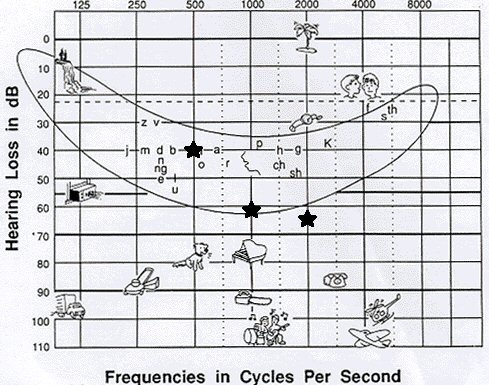It was only a few weeks ago that my boss at work asked me what frequency an octave is. We were planning to do an acoustical test for some fire insulation and it came up in the discussion. He figured as a musician I would know. Never having studied acoustics, I didn’t, but Google did of course. An octave is a doubling in frequency.
Right after I looked this up I received a package from UNC with all the different CI literature in it. It talked about frequencies and the piano keyboard and frequencies and the cochlea. So interesting.
In all these years I hadn’t really thought about my audiogram and a piano keyboard. Looking at my audiogram it looks like my hearing vanishes somewhere between 1000 and 2000 Hz. 1000 Hz is C6 – 2 octaves above Middle C. Yeah, that sounds about right from my memory of playing with a keyboard.
This page has a list of all the notes and their frequency and wavelength: Frequencies of Musical Notes
And this page has a Flash keyboard to play with: Flash Piano – the Method Behind the Music
Edited to Add: Here’s an even better piano to play with that goes from C2 to C7. Virtual Piano: Online music innovation at its best
I was looking for a piano online that went above C6 but haven’t found one yet. In Garage Band on my Mac however there is one that goes from C2 to C8 (except it has middle C as C3?! let’s ignore that). Above C6 (1000 Hz) notes do not sound distinctly different to me, and above C7 (2000 Hz) I can’t hear much beyond the F (2800 Hz).
What does all that mean to a non-musician, or non-piano player? Well Middle C is an easy note for men and women to sing. High for men, low for women, but not a stretch for either gender. C6 is a very high note for a woman to try to sing, I think A5 was the highest note I ever saw as a soprano in choir.
What does all this mean to me in my cochlear implant journey? Well it means that the human singing voice, and I suppose the frequency range of most instruments in a band (minus piccolo!) are less than 1000 Hz and thus in the range of what I can hear with my hearing aids. Wait, really? So why get a cochlear implant if you can already hear everything? It all comes back to understanding speech.
Here’s the speech banana:

If you look at the line from 1000 Hz at the top down – anything to the right is what I can’t hear, even with a hearing aid. I’m deaf in those frequencies. A CI helps a lot with those frequencies, but can often make the frequencies below 1000 Hz sound strange or at least different. How strange and different? I can’t tell you that as I haven’t experienced it.
Traditionally a cochlear implant meant that you would lose all hearing that you had left. It would be replaced by hearing through the implant. The new technology known as the hybrid implant, or electric-acoustic stimulation (EAS) tries to preserve residual hearing so that you can continue to use a hearing aid for the low frequencies and add the high frequencies through the CI. I promise I’ll write more about this next time.